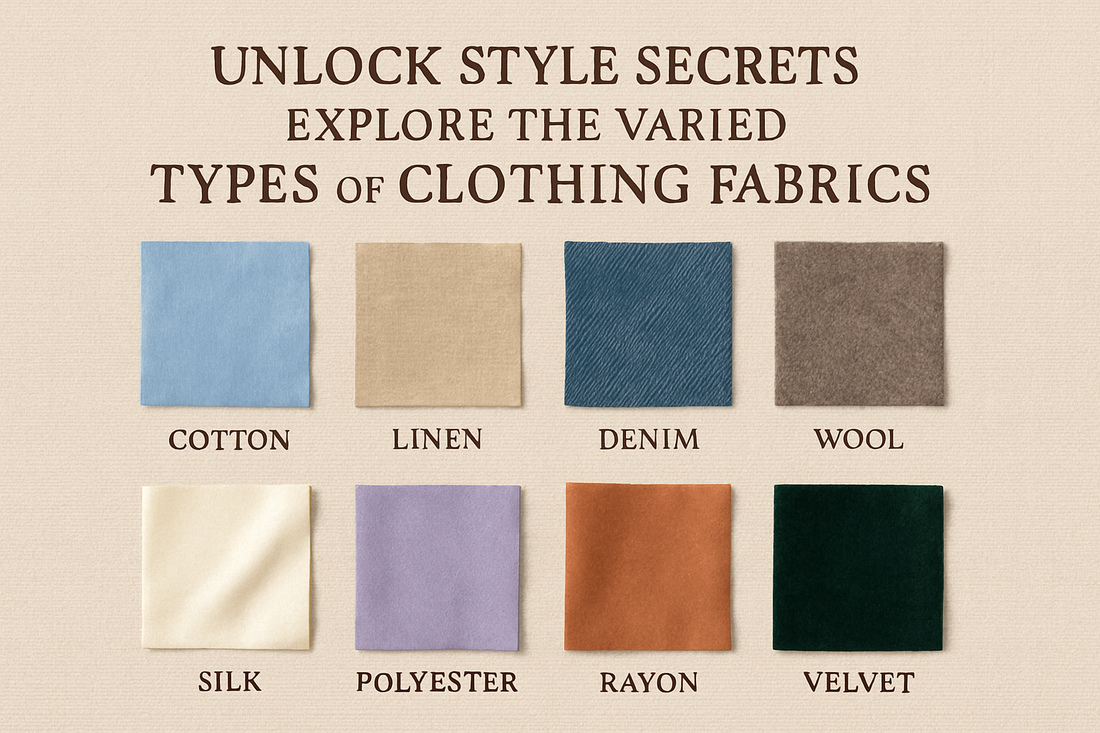The Fascinating World of Fabric
Every garment tells a story through its fabric. The textile you choose doesn't just determine how your outfit looks—it influences how it drapes on your body, how it feels against your skin, and how it performs throughout your day. For the discerning fashionista, understanding the nuances between different types of clothing fabrics isn't merely academic—it's essential for curating a wardrobe that's as functional as it is fabulous.
The tactile experience of a buttery-soft cashmere sweater versus the structured reliability of denim creates entirely different fashion narratives. Your fabric choices communicate your style sensibilities to the world before you even say a word. Whether you're drawn to the luxurious sheen of silk or the comfortable embrace of cotton, each textile carries its own unique properties and possibilities.
Let's embark on a textile journey to discover how understanding fabric types can elevate your style game to unprecedented heights.
Natural Fibers: Earth's Fashion Gifts
Natural fibers represent nature's contribution to our wardrobes—materials grown rather than manufactured. These fibers typically offer exceptional breathability, biodegradability, and a connection to traditional craftsmanship that synthetic alternatives simply cannot replicate.
Cotton: The Versatile Classic
Cotton reigns supreme as perhaps the most ubiquitous natural fiber in our closets. Its cultivation dates back thousands of years, with archaeological evidence suggesting cotton fabric production in Mexico, India, and Peru as early as 5000 BCE. This cellulose fiber harvested from the cotton plant's seedpod offers unparalleled versatility.
Different cotton varieties create distinct fabric experiences: Egyptian cotton with its extravagantly long fibers produces sumptuous, smooth textiles, while Pima cotton offers exceptional durability alongside luxurious softness. The everyday cotton in your t-shirts provides breathability that synthetic fibers struggle to match, making it the quintessential choice for warm-weather apparel.
Cotton's greatest strength lies in its chameleon-like adaptability. From lightweight gauze to sturdy denim, cotton can be woven or knitted into countless variations, each with distinct properties tailored to specific uses.
Linen: Summer's Perfect Companion
Few fabrics embody effortless sophistication quite like linen. Derived from the flax plant through an elaborate retting process, linen fibers create a textile with exceptional cooling properties. Its distinctive "rumpled" appearance—once considered a drawback—has become its signature aesthetic appeal, representing relaxed elegance.
Linen's hallmark characteristics include:
- Superior moisture-wicking capabilities
- Exceptional breathability even in sweltering conditions
- Natural resistance to bacterial growth
- Increasing softness with each wash
The fabric's natural structure creates microscopic breaks in the material that allow heat to escape from the body more efficiently than almost any other textile. This makes linen the unrivaled champion of summer wardrobes, particularly in humid climates where its ability to dry quickly prevents the uncomfortable clinging sensation other fabrics create.
Silk: Liquid Luxury
Silk represents the pinnacle of natural luxury in the textile world. Created through the miraculous metamorphosis of silkworm cocoons, this protein fiber requires approximately 2,500 cocoons to produce a single pound of raw silk. This labor-intensive process explains silk's historically exorbitant cost and status as a symbol of wealth and refinement.
"Silk does for the body what diamonds do for the hand." – Oscar de la Renta
The fabric's unmistakable luster comes from its triangular prism-like structure, which refracts incoming light at different angles, creating the characteristic shimmering appearance. Beyond its aesthetic appeal, silk offers practical benefits including natural temperature regulation—cooling in summer and insulating in winter—and hypoallergenic properties that make it suitable for sensitive skin types.
Synthetic Fibers: Innovation in Textiles
While natural fibers bring organic charm to our wardrobes, synthetic fibers represent human ingenuity in textile development. These laboratory-created materials have revolutionized fashion by offering performance capabilities that natural fibers cannot achieve.
Polyester: The Durable Workhorse
Polyester emerged in the 1940s as a revolutionary synthetic fiber derived from petroleum-based chemicals. Its molecular structure—essentially a form of plastic—creates a remarkably resilient textile that resists wrinkles, maintains shape, and dries rapidly. These qualities make polyester particularly valuable for activewear and travel garments.
Modern polyester has transcended its humble beginnings. Today's performance polyesters incorporate technological innovations like moisture-wicking properties, UV protection, and antimicrobial treatments. Microfiber polyester, with fibers finer than silk, creates luxuriously soft fabrics that belie their synthetic origins.
Environmental concerns have driven the development of recycled polyester, which repurposes plastic bottles into textile fibers. This eco-friendly alternative reduces landfill waste while maintaining the performance benefits of virgin polyester.
Nylon: Strength Meets Elasticity
Nylon disrupted the textile industry upon its introduction in 1938, offering unprecedented strength-to-weight ratio and remarkable elasticity. Originally developed as a silk alternative during wartime shortages, nylon quickly established itself as a textile powerhouse in its own right.
This synthetic polymer creates fabrics with exceptional durability while maintaining a surprisingly soft hand-feel. Its water-resistant properties and quick-drying capability make it ideal for outerwear and athletic apparel. The fiber's natural elasticity creates comfortable stretch without requiring additional elastic components.
Nylon's versatility allows it to mimic everything from delicate silk to rugged canvas, making it a chameleon in the textile world. Its light weight coupled with remarkable strength makes it particularly valuable for luggage, backpacks, and other items requiring durability without bulk.
Blended Fabrics: The Best of Both Worlds
The most innovative textiles often combine different fiber types to create fabrics with the advantages of each component while minimizing their individual weaknesses. These blended fabrics represent the cutting edge of textile development.
Cotton-Polyester Blends: Practical Performance
The marriage of cotton and polyester creates perhaps the most common fabric blend in modern wardrobes. This combination typically aims to preserve cotton's breathability and soft hand-feel while incorporating polyester's wrinkle resistance and durability.
Common cotton-polyester ratios include:
| Blend Ratio | Properties | Common Uses |
|---|---|---|
| 80% Cotton / 20% Polyester | Primarily cotton feel with enhanced durability | Premium t-shirts, casual shirts |
| 65% Cotton / 35% Polyester | Balanced properties of both fibers | Business casual attire, everyday clothing |
| 50% Cotton / 50% Polyester | Maximum wrinkle resistance with moderate breathability | Uniforms, affordable basics |
The ideal blend ratio depends on the garment's intended use. Higher cotton percentages provide greater comfort for items worn directly against the skin, while higher polyester content offers increased durability for garments subjected to frequent washing or rough use.
Choosing the Right Fabric for Your Style
Understanding fabric types transforms your shopping experience from guesswork to strategic selection. Each textile offers distinct advantages for different situations, body types, and personal preferences.
Climate Considerations
Your environment should significantly influence your fabric choices. In hot, humid climates, natural fibers like linen, lightweight cotton, and silk allow maximum breathability and moisture management. Cold weather calls for wool, cashmere, and flannel, which trap warm air against the body through their natural fiber structure.
Transitional seasons benefit from layerable fabrics with moderate insulation properties. Merino wool, medium-weight cotton, and technical synthetic blends offer versatility for temperature fluctuations throughout the day.
Body Type Enhancement
Different fabric weights and draping properties can strategically enhance your silhouette. Structured fabrics with substantial body—like denim, tweed, and heavy cotton blends—create shape and definition. Flowing, lightweight textiles such as silk charmeuse, rayon, and fine jersey drape elegantly over curves without adding visual bulk.
Understanding a fabric's natural inclination to cling, skim, or stand away from the body allows you to select textiles that complement your physique's natural strengths while strategically minimizing areas of concern.
Fabric Care: Preserving Your Textile Investment
Even the finest fabrics will deteriorate prematurely without proper care. Each textile type requires specific maintenance approaches to maintain its appearance and performance characteristics over time.
Some general fabric care principles include:
- Natural fibers typically benefit from air-drying rather than machine drying
- Most delicate fabrics should be washed in cold water to prevent shrinkage
- Wool and cashmere require specialized detergents to maintain their unique properties
- Synthetic performance fabrics often need washing in the absence of fabric softeners, which can compromise moisture-wicking abilities
Investing in proper fabric care not only extends your garments' lifespan but preserves their aesthetic appeal and functional performance throughout their use.
Embracing Fabric Knowledge for Style Mastery
Understanding the diverse world of clothing fabrics empowers you to make informed fashion choices that align with both your aesthetic preferences and practical needs. From the breathable comfort of natural fibers to the innovative performance of synthetics, each textile type offers unique possibilities for expressing your personal style.
The next time you're shopping, take a moment to examine fabric content labels. Consider not just how a garment looks on the rack, but how its textile composition will influence its performance in real-world conditions. This mindful approach to fabric selection elevates your wardrobe from merely fashionable to truly functional—creating a collection that serves you beautifully in every situation.
By unlocking the secrets of fabric types, you transform from a passive consumer into a discerning style curator—someone who understands that great fashion begins with the very fibers from which our clothing is created.

